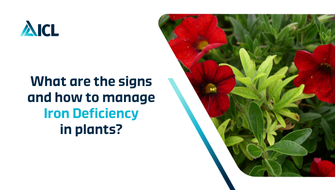Calcium deficiency in horticulture refers to a condition where plants do not receive an adequate supply of calcium, an essential nutrient for their growth and development.
Calcium plays a crucial role in cell wall formation, structural integrity, and various metabolic processes within plants. When plants lack sufficient calcium, they can exhibit a range of symptoms, experience negative impacts on their growth and productivity, and may require management strategies to address the deficiency.
What are the symptoms of Calcium Deficiency?
Leaf Symptoms
- Necrosis: One of the most common symptoms of calcium deficiency is the development of necrotic (dead) tissue at the tips and edges of young leaves.
- Leaf Curling: Affected leaves may curl or distort, and they may appear smaller than usual.
- Leaf Abnormalities: Leaves may exhibit irregular shapes and develop abnormal growth patterns.
Fruit Symptoms
- Blossom End Rot: This is a well-known symptom of calcium deficiency in fruiting plants, particularly in tomatoes, peppers, and eggplants. It manifests as a dark, sunken area at the blossom end of the fruit.
- Fruit Deformation: Fruits may become misshapen or have irregular growth patterns.
Root Symptoms
- Reduced Root Growth: Calcium deficiency can lead to stunted root development, which can affect the plant’s ability to absorb water and nutrients.

Calcium Deficiency in Primula
What are the impacts of Calcium Deficiency?
- Reduced Plant Growth: Calcium is essential for cell division and elongation. A deficiency can result in slower growth rates and reduced overall plant size.
- Poor Fruit Quality: Calcium deficiency can lead to the development of deformed or low-quality fruits, which may not be marketable.
- Increased Susceptibility to Diseases: Weakened cell walls make plants more susceptible to various diseases and pathogens.

Calcium Deficiency in Poinsettia
How should you manage Calcium Deficiency?
- Soil Testing: Start by conducting a soil test to determine the current calcium levels in your soil. This will help you determine if a deficiency exists.
- Liming: If the soil test reveals low calcium levels, you can amend the soil with agricultural lime (calcium carbonate) to raise the pH and provide a source of calcium. The application rate will depend on your soil’s specific needs.
- Fertilisation: Use calcium-containing fertilizers, such as calcium nitrate or gypsum, to provide a quick source of calcium to plants. Foliar sprays can also be used for a more immediate remedy.
- Proper Water Management: Irregular watering practices, especially inconsistent moisture levels, can exacerbate calcium deficiency. Maintain consistent soil moisture to ensure calcium uptake.
- Avoid Overfertilisation: While adding calcium is essential, excessive use of certain fertilizers (e.g., ammonium-based fertilizers) can lead to calcium deficiency by interfering with calcium uptake. Balance nutrient inputs to avoid this issue.
- Mulching: Applying organic mulch around plants can help maintain consistent soil moisture levels and regulate temperature, which can indirectly improve calcium uptake.
- Select Resistant Varieties: In some cases, choosing plant varieties that are less prone to calcium-related disorders can be a preventive measure.

Calcium Deficiency in Rosa
Remember that it’s crucial to diagnose calcium deficiency accurately through soil testing before applying any corrective measures. Additionally, maintaining balanced nutrient levels and proper cultural practices will contribute to overall plant health and reduce the risk of calcium deficiency in horticultural crops.
0 Brands found
0 Products found
13 Resources found














